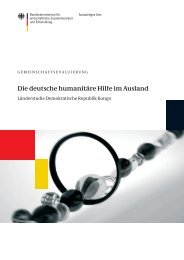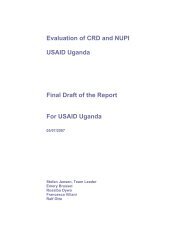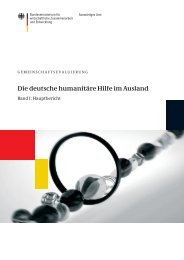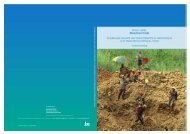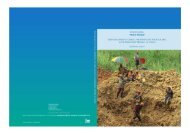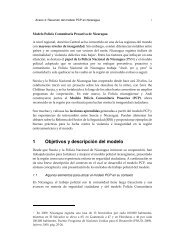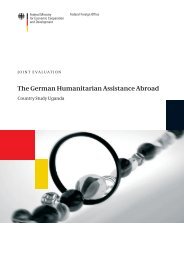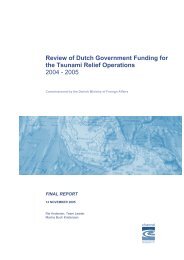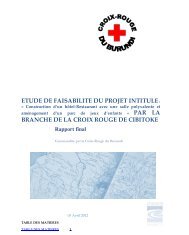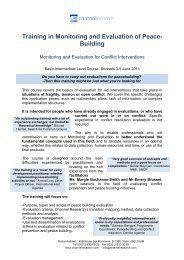A ripple in development? - Channel Research
A ripple in development? - Channel Research
A ripple in development? - Channel Research
You also want an ePaper? Increase the reach of your titles
YUMPU automatically turns print PDFs into web optimized ePapers that Google loves.
1.2 The LRRD concept 4<br />
LRRD is a multilayered concept. It means different th<strong>in</strong>gs to different<br />
actors and the implications for programmem<strong>in</strong>g fluctuate accord<strong>in</strong>g to<br />
the levels of chronic conflict and vulnerability <strong>in</strong> which relief, rehabilitation<br />
and <strong>development</strong> are expected to be l<strong>in</strong>ked. Effective transitions<br />
are reliant on appropriate l<strong>in</strong>ks with<strong>in</strong> aid architecture, programmem<strong>in</strong>g<br />
and methods <strong>development</strong>. LRRD is a matter relat<strong>in</strong>g to both <strong>in</strong>ternal<br />
agency procedures and external relationships. It demands creativity<br />
as each post-disaster context generates new <strong>in</strong>stitutional configurations<br />
and must be built on unique trajectories of <strong>development</strong> and change.<br />
All l<strong>in</strong>ks are not good l<strong>in</strong>ks. Re-<strong>in</strong>stat<strong>in</strong>g governmental authority<br />
and ownership <strong>in</strong> the midst of violent conflict is <strong>in</strong>herently problematic<br />
with<strong>in</strong> the humanitarian pr<strong>in</strong>ciples of neutrality, impartiality and <strong>in</strong>dependence.<br />
In terms of the <strong>development</strong>al pr<strong>in</strong>ciple of susta<strong>in</strong>ability, the<br />
smoothest ‘l<strong>in</strong>k’ that many humanitarian actors can make is often to<br />
leave quickly to ensure that relief modalities do a m<strong>in</strong>imum of damage<br />
to the <strong>development</strong> of stable <strong>in</strong>stitutions.<br />
The processes <strong>in</strong> which affected populations rebuild their lives are<br />
messy and do not slot <strong>in</strong>to aid programmem<strong>in</strong>g structures. After experienc<strong>in</strong>g<br />
a disaster people are not worried about ‘humanitarian pr<strong>in</strong>ciples’.<br />
They have to deal with trade-offs between their own survival today<br />
and their livelihoods tomorrow. They have <strong>in</strong>-depth knowledge about<br />
the local factors affect<strong>in</strong>g prospects for both, but are usually under<strong>in</strong>formed<br />
about the <strong>in</strong>tentions of the foreigners that are suddenly <strong>in</strong><br />
their midst.<br />
The LRRD concept should <strong>in</strong> pr<strong>in</strong>ciple be applied <strong>in</strong> the plann<strong>in</strong>g<br />
and evaluation of all humanitarian and disaster relief operations. It<br />
builds on the assumptions that there is both a severe time constra<strong>in</strong>t <strong>in</strong><br />
the <strong>in</strong>itial (life-sav<strong>in</strong>g) stage, which limits the range of possible activities,<br />
and a dist<strong>in</strong>ction between this <strong>in</strong>itial stage and the subsequent stages. At<br />
a m<strong>in</strong>imum, what is be<strong>in</strong>g done at the <strong>in</strong>itial stage should not harm later<br />
efforts for recovery, or at least possible negative effects should be consciously<br />
dim<strong>in</strong>ished while still reta<strong>in</strong><strong>in</strong>g the primary, operational objective<br />
of sav<strong>in</strong>g lives. If possible, humanitarian efforts should make a contribution<br />
to recovery and <strong>development</strong> processes and reduce the risk of<br />
future disasters.<br />
The awareness of the importance of this l<strong>in</strong>kage and how it affects<br />
the longer-term outcome of <strong>in</strong>terventions is widespread but the understand<strong>in</strong>g<br />
of the concept of LRRD varies considerably. It is all too easy<br />
to see the l<strong>in</strong>kage between immediate relief and rehabilitation or recovery<br />
as a simple operational sequence. In practice the different stages<br />
4<br />
The text <strong>in</strong> this section is partly borrowed from the LRRD1 Synthesis Report where the concept<br />
and its application <strong>in</strong> the tsunami context are exam<strong>in</strong>ed. For a comprehensive discussion of the<br />
LRRD concept, see Buchanan-Smith & Fabbri: L<strong>in</strong>ks between Relief, Rehabilitation & Development<br />
– A Review of the Debate (http://www.tsunami-evaluation.org/The+TEC+Thematic+Evalu ations/<br />
lrrd/LRRD+Evaluation+Sub-studies.htm)<br />
125



